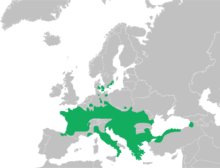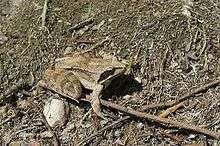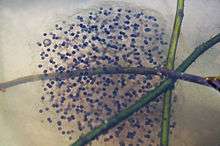Agile frog
| Agile frog | |
|---|---|
 | |
| Scientific classification | |
| Kingdom: | Animalia |
| Phylum: | Chordata |
| Class: | Amphibia |
| Order: | Anura |
| Suborder: | Neobatrachia |
| Superfamily: | Ranoidea |
| Family: | Ranidae |
| Genus: | Rana |
| Species: | R. dalmatina |
| Binomial name | |
| Rana dalmatina Fitzinger, 1839 | |
 | |
The agile frog (Rana dalmatina) is a frog in the genus Rana in the family of the true frogs.[2]
Description
This species is thin and has long limbs and a pointy snout. Adult males are rarely larger than 6.5 cm, while females can grow up to 8 cm. Its ventral surface is light brown, reddish-brown, or light greyish-brown with very little contrast. Triangle-shaped spots reach from the temple to the eardrum, which are dark brown. The underside of the agile frog is white without any spots. During mating season, the males often become dark brown.
The hind legs are unusually long, which allow this species to jump further than other similar frogs - they have been known to jump up to two metres in distance. The pupils are horizontal. The colour of the upper third of the iris (above the pupil) is lighter and gold in coloration. The tympanum is about the size of the diameter of the eye. The gland stripes on the frog's back are not very developed and partially interrupted.

Distribution
The agile frog can be found in France, the Channel Islands, parts of Germany, Italy, the Czech Republic, Austria, Hungary, on the Balkans, Greece, and by the Black Sea.
Reproduction

The call is a fairly quiet "rog ... rog ... rog", and can last for up to 12 seconds. They often also call under water, so the calls can only be heard from a very short distance by observers. Spawning only lasts a few days, and during this period, the males sometimes gather in large calling groups on the water surface to attracts females. In Central Europe, spawning usually occurs in the first 20 days of March, but can also be delayed, depending on the weather.
The spawn clumps consist of 450 to 1800 eggs, and are usually attached to tree branches, roots, or plant stems at depths of 5–40 centimetres (2.0–15.7 in). Therefore, they rarely sink to the bottom. Unlike the moor frog (Rana arvalis) and common frog (Rana temporaria), the agile frog does not lay its spawn all in the one clump. The diameter of a single egg, not counting the gelatinous shell, is 1.5–2.1 mm (0.059–0.083 in).
Habitat
The agile frog prefers light deciduous mixed forests with plentiful water. The open land around a forest is often also populated, as long as it is connected to the forest by shrubs. In dry, warm forests, this species often also lives far away from the water. Of the three Middle European Rana species, this frog likes warmth and dryness the most.
References
- ↑ Kaya, U.; et al. (2009). "Rana dalmatina". IUCN Red List of Threatened Species. Version 2013.1. International Union for Conservation of Nature. Retrieved 27 November 2013.
- ↑ Frost, Darrel R. (2013). "Rana dalmatina Fitzinger, 1839". Amphibian Species of the World 5.6, an Online Reference. American Museum of Natural History. Retrieved 27 November 2013.
